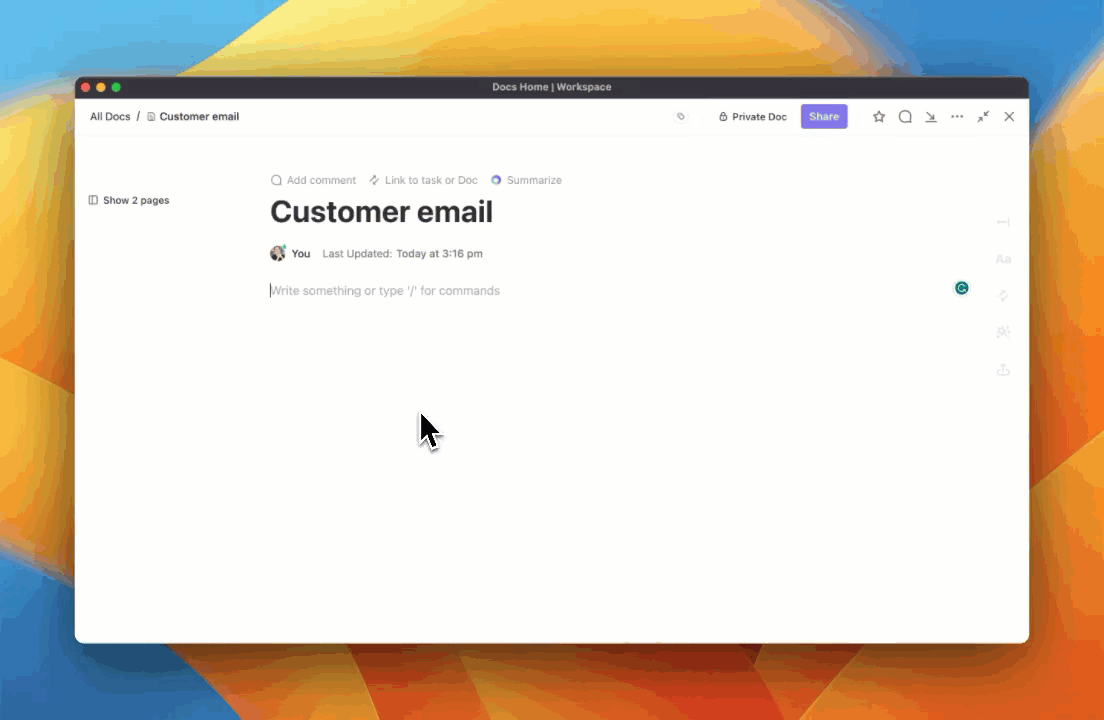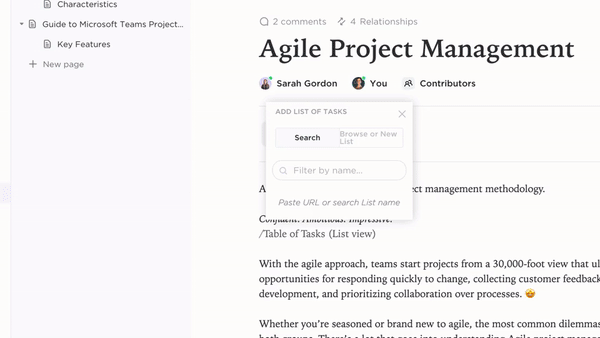نحن في عام 2024، ويجب أن يكون عبء تذكر كل التفاصيل الصغيرة شيئاً من الماضي.
يجب أن تمنح عقلك استراحة للتفكير بحرية والإبداع. ولكن كيف يمكنك القيام بذلك عندما يكون هناك كثير من المعلومات الزائدة؟ إن المعرفة التي من المفترض أن تمكّنك، بدلاً من ذلك، تعيقك.
سواء كنت تتصفح حاسوبك المحمول في مكان العمل أو تتصفح وسائل التواصل الاجتماعي في المنزل بلا تفكير أو تتصفح وسائل التواصل الاجتماعي بلا تفكير في المنزل، فهناك الكثير من المعلومات والبيانات التي تأتيك في كل ثانية. وبغض النظر عن مصدر التحفيز، فإنه يؤدي في نهاية المطاف إلى زيادة التحميل المعلوماتي على عقلك.
والعلاج هو تنظيم المعلومات وإدارتها بطريقة تحافظ على إنتاجيتك. ماذا لو كان بإمكانك حفظ معلوماتك في بيئة رقمية يمكنك الوصول إليها في أي وقت؟
ستحتاج حينها إلى الاحتفاظ بالمعلومات الأكثر أهمية فقط في دماغك. وبالتالي، لا مزيد من الأعصاب المتوترة والصراع من أجل تتبع كل شيء.
يمكنك تحقيق ذلك من خلال بناء دماغ ثانٍ لإدارة المعرفة الشخصية. فهو يساعدك على الاحتفاظ بكل هذه المعلومات المهمة في مساحة رقمية يمكنك الرجوع إليها متى شئت.
لذا، دعنا نفهم كيف يمكن لمفهوم BASB أن يغير حياتك للأفضل.
ما هو بناء دماغ ثانٍ؟
بناء دماغ ثانٍ (BASB)، كما هو مفهومه من قبل تياغو فورتي (أحد أبرز الخبراء في العالم في مجال الإنتاجية)، هو نهج منهجي لإنشاء مستودع رقمي لتنظيم الأفكار الوفيرة التي تصادفك يوميًا واتخاذ إجراءات بشأنها.
نظرًا للنمو الهائل في استهلاكنا على الإنترنت، فإن محاولة تذكر كل هذه المعلومات تصبح غير عملية. ومع ذلك، من خلال دمج هذه الثروة من المعلومات في موقع واحد يسهل الوصول إليه، ستشهد نموًا كبيرًا في إنتاجيتك.
إن وجود مساحة منظمة لتخزين المعلومات وتنظيمها يتيح لعقولنا حرية التفكير والتخيل والحضور في الوقت الحالي. وعلاوة على ذلك، عندما لا تكون مثقلًا بالضغط المستمر لمحاولة تذكر كل شيء، فإنك تتخذ الإجراءات الصحيحة.
c.o.d.e. & p.a.r.a.a.a.a.a
قدم فورتي كذلك مبدأين مهمين كجزء من بناء الدماغ الثاني. دعونا نفصلهما:
C.O.O.D.E: التقط، ونظم، واستخلص، وعبّر
تساعدك هذه الطريقة المكونة من أربع خطوات على تنظيم المعلومات وتحويلها إلى نتائج ملموسة:
- التقاط: اجمع المعلومات بشكل منهجي من مصادر مختلفة، مثل المقالات أو مقاطع الفيديو أو غيرها من المحتويات. استخدامأدوات الذكاء الاصطناعي لتدوين الملاحظاتالتقاط المعلومات والرؤى ذات الصلة
- التنظيم: بمجرد الحصول على المعلومات، قم بتصنيفها وتخزينها بطريقة تجعل الوصول إليها سهلاً عند الحاجة إليها
- التستّر: استخلاص الرؤى الأساسية أو الوجبات الرئيسية من المعلومات التي تم جمعها
- التعبير: أخيرًا، قم بتوضيح المعلومات المستخلصة والتعبير عنها من خلال تدوين الملاحظات أو التلخيص أو حتى إنشاء محتوى بناءً على الرؤى المكتسبة
P.A.R.A.A: المشاريع والمجالات والموارد والمحفوظات
وفقًا لفورتي، يمكن تقسيم جميع المعلومات في حياتك إلى أربع فئات فقط:
- المشاريع: هذه الفئة مخصصة للمهام أو المبادرات المحددة التي تعمل عليها بنشاط مع جميع المعلومات والمهام والموارد ذات الصلة المتعلقة بتلك المشاريع. على سبيل المثال، قد تتضمن مشاريعك كتابة تقرير، والتخطيط لحدث ما، وشراء أثاث جديد لمنزلك، وتعلم الطهي.
- المجالات: تمثل المجالات جوانب أوسع من حياتك أو عملك التي تشمل أهدافًا أو مسؤوليات طويلة الأجل. على سبيل المثال، مسؤوليات العمل مثل إدارة المنتجات وفرق التدريب، ومسؤوليات المنزل مثل المنزل والأطفال والشؤون المالية وما إلى ذلك.
- المصادر: هذه الفئة مخصصة للمعارف القيّمة التي قد لا ترتبط مباشرةً بمشروعك ولكنها تتعلق بمجالات اهتماماتك وقد تكون مفيدة في المستقبل، مثل المواد المرجعية أو الأدوات أو المعلومات. على سبيل المثال، معلومات عن التمويل الشخصي، وتكوين العادة، وزراعة الأعشاب، والأعمال الخشبية، وما إلى ذلك.
- الأرشيفات: الأرشيفات تخزن المشاريع المكتملة أو المعلومات القديمة أو أي شيء لا يتطلب اهتمامًا فوريًا ولكنه قد يكون مفيدًا للرجوع إليه في المستقبل
## فوائد استخدام طريقة BASB
يساعد بناء عقلك الثاني على التخلص من التوتر الذي يصاحب الاستهلاك المستمر للمعلومات. ولكن هذا ليس كل شيء؛ إليك بعض الفوائد الأخرى لهذه الطريقة التي أثبتت جدواها:
الفائدة 1: لا يوجد حمل زائد من المعلومات
هل سبق لك أن شعرت بالإرهاق الشديد من كثرة المعلومات التي تستهلكها على الإنترنت؟ لنفترض أنك حضرت في أسبوع واحد سلسلة من الندوات عبر الإنترنت، وقرأت العديد من المقالات حول الاتجاهات الحديثة، وشاركت في مجتمعات أو مناقشات عبر الإنترنت.
يواجه دماغك حملاً زائداً من المعلومات ويحتاج إلى مساعدة في تنظيم المعلومات وتصنيفها. وهنا يأتي دور منهجية الدماغ الثانية. إذا لم يكن الأمر كذلك، فسوف تنسى التفاصيل المهمة قبل أن تدرك ذلك، ومحاولة ربط النقاط فيما بعد ليست ممتعة!
باستخدام أدوات حديثة مثل تطبيقات تدوين الملاحظات , اللوحات البيضاء الافتراضية , الخريطة الذهنية ق، و تطبيقات الدماغ الثانية ، يمكنك الاحتفاظ بهذه المعلومات وتوصيلها بشكل فعال مع فريقك. عندما تبدأ في جمع وتدوين المعلومات الأساسية المستفادة وتدوينها، فإنك تنقذ نفسك من الغرق في المعلومات غير ذات الصلة وتركز فقط على التفاصيل المهمة.
الفائدة 2: استرجاع المعرفة دون عناء
لنكن صادقين؛ لا أحد لديه الوقت الكافي للبحث في التفاصيل عن المعلومات التي يمكنه استخدامها في اتخاذ القرارات الاستراتيجية. لهذا السبب تحتاج إلى المعلومات الأكثر أهمية في متناول يدك.
على سبيل المثال، تخيل أنك تحضّر لعرض تقديمي، وهو أمر يستغرق وقتاً طويلاً ويتطلب منك جمع الكثير من المعلومات وعرضها في كلمات قليلة. أنت تتصفح عشرات المقالات البحثية والتقارير الصناعية والملاحظات الرقمية من العروض التقديمية السابقة، وما إلى ذلك.
في مثل هذا الموقف المرهق الذي يتطلب منك الكثير من المعلومات لجمعها وتقديمها، تساعدك طريقة BASB على تخزين النقاط الرئيسية من بحثك في مساحة عمل رقمية. عندما يتم تخزين كل شيء في مكان واحد، يمكنك أن توفر على نفسك عناء تبديل السياق .
لذا لخص النقاط الرئيسية، واستخدم تقنيات رسم الخرائط الذهنية لنقل سرد مقنع، ودوّن الأفكار والزوايا المبتكرة عند ظهورها أثناء البحث.
عندما يحين الوقت المناسب، استرجع هذه المعلومات بسهولة وأنشئ عرضك التقديمي النهائي دون أن تشعر بأنك تفتقد شيئاً ما.
الفائدة 3: المساعدة في وضع الأفكار الإبداعية
عندما يكون لديك تدفق مستمر من الأفكار والإلهامات، يجب عليك تدوين الأفكار والخواطر عند ظهورها بسرعة. ثم قم بتنظيمها في فئات ذات صلة لتجنب الارتباك عند العودة إليها لاحقًا.
تساعدك طريقة BASB على إنشاء مستودع مركزي حيث يمكنك تخزين الصور أو الاقتباسات أو المقالات أو أي مصدر آخر للإلهام. يكون لديك شيء يمكنك الرجوع إليه والتصرف بناءً عليه عندما تواجه عقبات إبداعية.
كما تتيح لك أيضًا الجمع بين الأفكار المختلفة واستكشاف إمكانيات جديدة وتوفير مساحة للتجربة. وعندها ستتحدث النتائج المبتكرة والفريدة من نوعها عن نفسها.
ضع في اعتبارك أيضًا استخدام قوالب السبورة التفاعلية إذا كنت تريد نهجًا تعاونيًا أثناء وضع الأفكار. ستوفر لك هذه السبورات البيضاء الوقت حيث ستعمل أنت وفريقك جميعًا في نفس المساحة دون الحاجة إلى مشاركة الشاشات بشكل متكرر. تواصلوا وتشاركوا الأفكار معًا بسهولة للحصول على أفضل النتائج.
الفائدة 4: إنجاز المشروع بشكل متسق
تساعدك طريقة BASB على تقسيم المشاريع المعقدة إلى مكونات يمكن إدارتها، وتعيين مراحل الإنجاز، وتتبع التقدم المحرز باستمرار. إنها مفيدة، خاصةً إذا كنت تعمل على مشاريع مختلفة في وقت واحد.
لنفترض أنك مدير مشروع في وكالة إبداعية. استخدم مساحة العمل الرقمية الخاصة بك لإنشاء تفاصيل خطط المشروع وقوائم المهام، وتحديد أولويات الأنشطة، وتصنيفها بناءً على مدى إلحاحها. سيساعدك هذا على إنهاء مهامك في الوقت المحدد وبما يتماشى مع المتطلبات.
في الوقت نفسه، استخدم عقلك الثاني لتوثيق جميع التفاصيل المتعلقة بالمشروع، بما في ذلك القرارات والتحديات التي واجهتها والاستراتيجيات الناجحة المستخدمة. يصبح ذلك مرجعاً قيماً في المستقبل ويضمن عملية تعلم مستمرة.
أيضًا، إذا كنت قلقًا بشأن إكمال المشاريع في الوقت المحدد، فحاول استخدام تطبيقات العقل الثاني لإبقاء كل شيء على المسار الصحيح وتجنب التأخير.
التحديات الشائعة لبناء دماغ ثانٍ ## التحديات الشائعة لبناء دماغ ثانٍ
الحمل الزائد للمعلومات
يغمرنا العصر الرقمي بمعلومات وفيرة، ويصبح تحديد ما يجب التقاطه وتجاهله مهمة شاقة. لنفترض أنك تريد البقاء على اطلاع على أحدث الاتجاهات والأبحاث والأخبار.
حتى البحث السريع على Google سيؤدي إلى ظهور العديد من النتائج التي ستجعلك في حيرة من أمرك بشأن أي منها يجب حفظها. يمكن أن يكون الحجم الهائل من البيانات المتاحة مربكًا، مما يجعل من الصعب عليك التدقيق في البيانات المتاحة وتحديد ما هو مناسب حقًا.
الحفاظ على الاتساق وسط التسويف
الحفاظ على نظامك الشخصي لعقلك الثاني ليس بالمهمة السهلة. يمكن أن يسيطر عليك التسويف بسهولة، مما يؤدي بك إلى العودة إلى طرقك السابقة (غير المنظمة). ومن المحتمل حدوث مثل هذا الموقف إذا كان دماغك الثاني مجرد مستند من مستندات Google يمكن أن تضيعه من بين مئات المستندات الأخرى.
يمكن أن يؤدي هذا التناقض إلى أن يصبح دماغك الثاني مساحة تخزين رقمية أكثر من كونه أداة إنتاجية. تذكر أنه ليس من المفترض أن يكون دماغك الثاني مقبرة رقمية لا تتفاعل أو لا تتفاعل معها أو لا تمارس أي نشاط.
قد يكون اختيار التكنولوجيا المناسبة أمرًا مربكًا
يضيف اختيار التكنولوجيا المناسبة لبناء عقل ثانٍ طبقة أخرى من التعقيد إلى العملية. يقدم السوق العديد من الأدوات والمنصات، ولكل منها ميزات وفوائد.
وفي خضم هذه الوفرة الهائلة من الخيارات، قد تخشى من اتخاذ القرار الخاطئ. نقترح عليك تقييم التقنيات المختلفة بعناية، مع الأخذ في الاعتبار عوامل مثل سهولة الاستخدام والتوافق مع تدفقات العمل الحالية والجدوى على المدى الطويل.
الخوف من الفشل في النظام
يأتي بعد ذلك الخوف المستمر من الفشل مع النظام. قد يكون استثمار الوقت والجهد في بناء عقل ثانٍ، ثم رؤيته يتعثر، سببًا للقلق. وقد يؤدي هذا الخوف إلى التردد في الالتزام الكامل بالعملية، مما يعيق فعالية الدماغ الثاني.
كيف تبني دماغًا ثانيًا؟
الخطوة 1: حدد مشاكلك
تتمثل الخطوة الأولى نحو بناء دماغ ثانٍ في تحديد التحديات الأكثر شيوعًا التي تواجهك. على سبيل المثال، هل تجد صعوبة في تصفية الأفكار القيمة والاحتفاظ بها؟ أو هل يمثل تطبيق المعلومات المستهلكة مشكلة كبيرة بالنسبة لك؟
استمر في سؤال نفسك عن المجالات التي تجد نفسك عالقًا فيها. قم بتدوين هذه التحديات المحددة لضمان حصولك على المعلومات المطلوبة واستخدام النهج الصحيح لبناء عقل ثانٍ.
على سبيل المثال، لنفترض أنك تعاني من عوائق الإبداع. يساعدك BASB على إنشاء مساحة عمل رقمية لسرد جميع الأفكار الرائعة التي تتبادر إلى ذهنك. وبهذه الطريقة، يكون لديك شيء يمكنك الوصول إليه عندما يصبح عقلك فارغًا.
الخطوة 2: التقط المعلومات الصحيحة
أنت تعرف الآن التحديات التي يجب أن تواجهها باستخدام عقل ثانٍ. ومع ذلك، من الضروري التقاط المعلومات الصحيحة، حيث لا تكون كل المعلومات ذات قيمة متساوية. وهنا يأتي دور جلسة العصف الذهني مع تقنيات التفكير الصحيحة تساعدك على جمع المعلومات الصحيحة.
من الأفضل استخدام تنسيقات متنوعة لالتقاط المعلومات، مثل الملاحظات والنصوص والصور والروابط والتسجيلات الصوتية والرسومات التخطيطية.
إذا كنت ترغب في دمج العصف الذهني في عملية التقاط المعلومات لعقلك الثاني، فيجب عليك ذلك:
- إنشاء فئات أو مواضيع لأنواع المعلومات التي تريد التقاطها
- تحديد خطوات أو مهام قابلة للتنفيذ مرتبطة بالمعلومات التي تريد التقاطها
- استخدم أداة ذكاء اصطناعي مثلClickUp AI لتوليد الكثير من الأفكار حول مواضيع مختلفة. إذا كنت تخطط لإطلاق حملة جديدة، فقم بعصف ذهني للأفكار. كل ما عليك فعله هو أن تذكر أفكارك، وينتهي الأمر!

استخدام ClickUp AI كقوة سريعة لتوليد فن ذكاء اصطناعي مذهل
استخدم الأداة لتلخيص المعلومات الأساسية وتخزينها. على سبيل المثال، لنفترض أنك أجريت اجتماعاً لفريق العمل ولديك نسخة منه. تساعدك الأداة على تلخيصه للرجوع إليه في المستقبل.

استخدام ClickUp AI لصياغة المحتوى وتحريره وتلخيصه في غضون ثوانٍ
- استخدم العلامات والكلمات الرئيسية أثناء العصف الذهني لتحديد الموضوعات والمفاهيم الرئيسية
- استخدم أدوات مرئية مثل الخرائط الذهنية أو الرسوم البيانية أو خرائط المفاهيم
- قم بتنقيح أفكارك والتقاط المعلومات مع تطور عقلك الثاني
بالإضافة إلى ذلك، قم بتطوير عادة التقاط المعلومات عندما تصادفها. سواء كان ذلك من خلال تطبيقات تدوين الملاحظات أو المذكرات الصوتية أو أدوات وضع الإشارات المرجعية، التقط أي شيء ذي صلة باهتماماتك وعملك.
إذا كنت لا تزال بحاجة إلى المزيد من المساعدة في العصف الذهني، فحاول استخدام برنامج العصف الذهني لضمان عدم نفاد الأفكار مرة أخرى.
الخطوة 3: اختر الأدوات والتقنية المناسبة
يتعلق بناء عقل ثانٍ بتنظيم المعلومات وتصنيفها واسترجاعها عند الحاجة. بينما يمكنك قضاء ساعات في معالجة هذه المهام يدويًا، فإن الاستثمار في برنامج إدارة المعرفة سيجعل عملك أسهل.
باستخدام التكنولوجيا المناسبة، يمكنك حتى الوصول إلى عقلك الثاني أثناء التنقل على أجهزة متعددة. قم بتخزين المعلومات بطريقة يسهل فهمها عند الوصول إليها بعد فترة. على سبيل المثال مستندات ClickUp تأتي مع العديد من خيارات التصميم والتنسيقات المختلفة لجمع معلوماتك وتقديمها.

استخدم مستندات ClickUp لإنشاء مستندات جميلة ومواقع ويكي والمزيد من أجل تنفيذ الأفكار بسلاسة مع فريقك
يمكن للفرق المختلفة التعاون بسهولة على المستند والعصف الذهني معًا. قم بإنشاء عقل ثانٍ يحافظ على كل شيء سليم للجميع. يساعد التحرير في الوقت الفعلي على ضمان عدم تفويت الأفكار المهمة أثناء المناقشات.

ربط مستندات ClickUp Docs بسير عملك من خلال ربط المهام معًا ClickUp Whiteboards تساعدك على نقل العصف الذهني إلى المستوى التالي. هذا النوع من التعاون المرئي مفيد بشكل خاص للفرق البعيدة أو المختلطة. يتيح لك الجمع بين هذا مع قوالب العصف الذهني المناسبة عقد بعض جلسات العصف الذهني الرائعة مع فريقك.

_ClickUp يقدم اللوحة البيضاء الافتراضية الوحيدة في العالم التي تحول أفكار فريقك إلى إجراءات منسقة - كل ذلك في مكان واحد
وأخيراً، فإن تنظيم المعلومات أمر بالغ الأهمية لبناء عقل ثانٍ. قم بتصنيف هذه المستندات بسهولة وأضفها أينما كانت في مساحة العمل الخاصة بك للرجوع إليها بسرعة.
الخطوة 4: إنشاء هيكل تنظيمي
يجب أن تضع هيكلاً تنظيميًا لعقلك الثاني (C.O.D.E و P.A.R.A). لديك بالفعل أجزاء مختلفة من المعلومات التي تتطلب تسلسلاً هرميًا يعكس العلاقة بينها.
وهنا يأتي دور أدوات الذكاء الاصطناعي لرسم الخرائط الذهنية مثل انقر فوق الخرائط الذهنية تساعدك على تصور أفكارك ورسم الروابط بين المهام والأفكار. تتيح لك ميزة السحب والإفلات البسيطة تعديل مهام سير العمل الحالية.

تخطيط المشاريع أو الأفكار أو المهام الحالية وتنظيمها باستخدام خرائط ClickUp الذهنية.
والجزء الأفضل؟ إنشاء المهام أو تعديلها أو حذفها مباشرةً من خريطتك الذهنية دون الانتقال إلى طرق عرض أخرى. يضمن لك هذا التمثيل المرئي إنشاء عقل ثانٍ يساعدك على الاحتفاظ بالمعلومات واتخاذ الإجراءات عند الضرورة.
الخطوة 5: جدولة المراجعات
بناء عقل ثانٍ ليس عملية لمرة واحدة. يجب عليك تخصيص وقت لإعادة النظر في ملاحظاتك وتقييم المعلومات الجديدة وتحسين تنظيمك. وهذا يضمن أن يظل عقلك الثاني ملائمًا ودقيقًا، ويستمر في التطور جنبًا إلى جنب مع أفكارك ومشاريعك.
خصص مراجعة أسبوعية لمدة ساعة واحدة أو نحو ذلك. أثناء عملية المراجعة، ركز على ما يلي:
- تفحص الهيكل العام لعقلك الثاني بشكل عام
- التحقق من وجود أي تحديثات أو تغييرات رئيسية في مشاريعك أو مجالات تركيزك
- مراجعة الملاحظات والإدخالات التي تم تدوينها خلال الأسبوع الماضي
- تأكد من تصنيف المعلومات الجديدة وربطها بشكل صحيح داخل النظام
- خذ لحظة للتفكير في أي أفكار أو روابط اكتشفتها
- تحقق من حالة المهام والمشاريع
- قم بتحديث أي مواعيد نهائية أو أولويات أو مهام مكتملة
في حين أن المراجعات الأسبوعية مثمرة، يجب عليك أيضًا جدولة غوص عميق شهريًا حيثما أمكنك ذلك:
- تحديد المواضيع أو الأنماط الشاملة التي ظهرت خلال الشهر الماضي
- النظر في كيفية ارتباط هذه المواضيع بأهدافك طويلة المدى
- التفكير في المجالات التي قد يكون عقلك الثاني يفتقر إلى المعلومات
- التخطيط للبحث المستهدف أو تدوين الملاحظات لسد هذه الفجوات
- تقييم فعالية أدواتك وتقنياتك الحالية
- استكشف الميزات أو المنصات الجديدة التي قد تعزز تجربة عقلك الثاني
استناداً إلى هذه المراجعات استخلص الرؤى وحدد الاتجاهات والروابط والأنماط التي تظهر مع مرور الوقت. سيؤدي ذلك إلى تعزيز قدراتك في اتخاذ القرار والإبداع بشكل عام.
بناء دماغ ثانٍ باستخدام الأدوات والتكنولوجيا المناسبة
الآن وقد قررت أخيراً بناء دماغ ثانٍ يحتفظ بالمعلومات، تخلص من العبء اليدوي.
يمكن للأدوات والتكنولوجيا تحسين عملياتك بسرعة وتقليل فرص ضياع المعلومات. ففي النهاية، أنت بحاجة إلى دماغ ثانٍ تعود إليه عندما تشعر بأنك عالق.
باستخدام ClickUp، يمكنك الوصول إلى مجموعة من الأدوات لتخزين المعلومات بالطريقة التي ترغب في عرضها. تصرف بسرعة في المهام، وتعاون مع الآخرين، وحقق أقصى استفادة من المعلومات التي تجمعها عبر الإنترنت.
سواء كنت تستخدم المستندات، أو الخرائط الذهنية أو السبورات البيضاء، يضمن لك ClickUp عدم انزلاق المعلومات من بين يديك، وتحول أفكارك إلى نتائج ذات مغزى.
هل تريد معرفة كيف يمكن أن يساعدك ClickUp في إنشاء عقل رقمي؟ تواصل مع فريقنا اليوم أو اشترك مجاناً!
أسئلة وأجوبة BASB
كيف يختلف العقل الثاني عن نظام تدوين الملاحظات التقليدي؟
على عكس تدوين الملاحظات التقليدي، ينطوي الدماغ الثاني على نهج أكثر تنظيماً وترابطاً. وهو يركز على إنشاء مساحة عمل رقمية يتم فيها تنظيم المعلومات وربطها وسهولة استرجاعها.
كيف أقرر ما هي المعلومات التي سأقوم بتضمينها في الدماغ الثاني؟
قم بتضمين المعلومات ذات الصلة بأهدافك الشخصية والمهنية. ركز على التقاط الرؤى والأفكار وتفاصيل المشروع وأي شيء يساهم في معرفتك وعملية اتخاذ القرار.
هل العقل الثاني مخصص للمعلومات المتعلقة بالعمل فقط؟
لا، فالدماغ الثاني هو مستودع رقمي منظم يشمل العديد من المواضيع، بما في ذلك الاهتمامات الشخصية والهوايات وأي مجال تريد جمع المعلومات وتنظيمها فيه.
هل يمكنني مشاركة عقلي الثاني مع الآخرين؟
اعتماداً على المنصة التي تختارها، قد يكون لديك خيار مشاركة أجزاء محددة أو الدماغ الثاني بأكمله مع الآخرين. يوفر ClickUp، على سبيل المثال، مساحة عمل تعاونية حيث يمكنك التفكير والتنفيذ كفريق واحد.
هل عملية بناء العقل الثاني تستغرق وقتاً طويلاً؟
قد يكون هناك منحنى تعليمي في البداية، لكن الفوائد طويلة الأجل لزيادة الإنتاجية وإدارة المعلومات غالباً ما تفوق استثمار الوقت الأولي.

